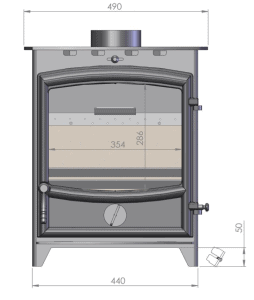With uncertainty around lockdowns, tiers and other things pressing us at this current time now is the perfect time to read up on our stove tips, to make sure you are getting the most from your stove during these cold, dark, challenging weeks ahead!

Tip 1 – The best fuel for stoves is hardwood logs having no more than 20% moisture content for the best burn. Kiln-dried or seasoned work equally as well, but they must be seasoned long enough to achieve low moisture levels.
Tip 2 – Smartening up most stoves is straightforward and can be done yourself. An annual summer re-spray or re-paint with stove black is often the best way to maintain a first-class finish. An interim tidy up can be carried out using WD40 on a clean rag. Beware white smearing can dry on to the black paint if using a wet cloth and ash or stone/tile dust gets mixed in.
Tip 3 – Give your stove a thorough internal clean from time to time. Firstly drop down the baffle plate and brush off any ash or debris. Rake out the grate and empty the ash pan. Brush the grate and firebox liners with a hand brush or for the best finish use a vacuum brush attachment (make sure the stove is cold!). Finally, wipe the glass with household glass cleaner or ceramic hob cleaner and buff it off.
Tip 4 – Don’t want to handle logs, firelighters and ash – but would love to have a stove? Simple – take a look at our gas stove models. You can have the look of a freestanding stove in a fireplace chamber, but with the convenience of natural or bottled gas to run it. Flickering flames and realistic detailed ceramic logs, inside the solid steel stove body, really do give all the style of a solid fuel burner, without any of the inconvenience!
Tip 5 – Squeaking handle or stove door hinges? This is a simple problem to fix – just use a smear of copper or graphite-based grease from a motorist or DIY store, to lubricate the hinge pins and mating surfaces. It also works for air control threads and similar.
Tip 6 – Preventing condensation or rusting on stoves, when out of use is easy using a spray of WD40, or light machine oil, which keeps out moisture from surroundings until the stove is used again.
Tip 7 – Load logs into your stove carefully – use the leather gauntlets provided, to position one or two chunky logs within the firebox for the best flame picture and combustion.
Tip 8 – Use your stove air-wash air control to keep the stove glass as clear as possible, when burning wood. Good dry logs should require little or no primary (under grate) air and will burn very well with the air wash (secondary) air supply only. Single air control stoves will do this automatically, by proportioning the air correctly on the wood setting.
Tip 9 – Reduce the amount of smoke, and keep the glass of your stove cleaner during ignition, by using the top-down ignition method. Put two small-diameter logs on the grate of the stove, two further logs crossed over the first pair, followed by a firelighter and a “jenga” style criss-cross crib of kindling on top. The wood must be fully dry, but once the fire lights, it should burn down to the base logs, and be ready for the next fuel load with little intervention.
Tip 10 – Use wood “wool” and wax firelighters instead of the white chemical ones – they do not smell, produce much less soot and smoke, and are far more likely to light the fire successfully using just one.
Tip 11 – Use your stove gloves when operating the door handle, and air controls of your stove. They are provided for that reason and prevent the burning of your fingers!
Tip 12 – Use a stovepipe thermometer to monitor the approximate temperature levels in the flue pipe. This can help to get optimum flue temperatures more quickly and reduce tar, condensation and soot formation in the chimney.
Tip 13 – Don’t slumber your stove (burning very slowly) as a habitual operating method. The smoke and chemicals that can be released, will shorten the life of the stove itself, the chimney, and particularly flue liners.
Tip 14 – Smokeless coal type products need to be burnt with care to avoid damaging your stove. Once ignited properly, be sure to regulate the air control to a slower burn rate, to avoid over firing, and possible damage from overheating.
Tip 15 – Flue liners are not essential in all chimneys, but professional advice should definitely be sought as each property and chimney is different.
Tip 16 – For maximum safety always fit a CO (Carbon Monoxide) detector in the same room as a solid fuel combustion appliance of any kind.
Tip 17 – Never burn painted or preserved wood (such as treated decking). It is illegal and will cause a build-up of tar and soot, and will cause damage to your stove and flue, or flue liner.
Tip 18 – Never burn house coal on closed stoves, it can cause severe soot build-up, and will not provide a good heat output, compared to proper closed stove fuel.
Tip 19 – Always burn the best fuel you can afford. Hardwood logs are the best and can be bought kiln dried ready for use.
Looking for a new stove? You can search for a showroom near you.







